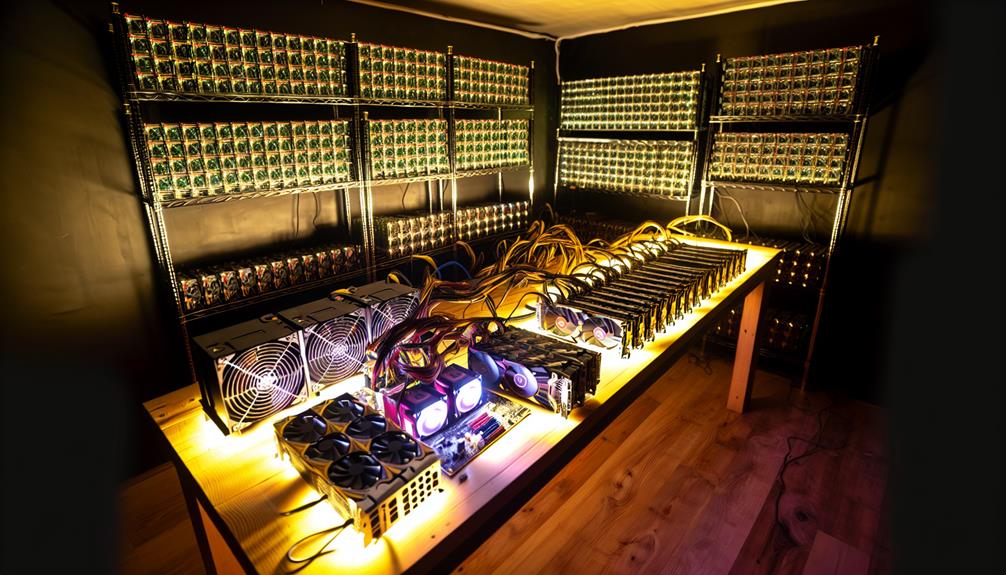You might be wondering if you can still mine Ethereum, especially with all the buzz around cryptocurrencies. However, since Ethereum changed to Proof of Stake with Ethereum 2.0, traditional mining methods are no longer applicable. This shift not only affects the equipment you'd typically need but also changes how you can engage with the network. So, what does this mean for your potential involvement and the opportunities that still exist? Let's explore the options available to you in this new landscape.
Understanding Ethereum Mining

Ethereum mining involves the process of validating transactions and adding them to the blockchain, which requires significant computational power. To successfully mine Ethereum, you need to understand how mining algorithms operate. Ethereum primarily utilizes the Ethash algorithm, designed to be memory-hard, making it resistant to ASIC (Application-Specific Integrated Circuit) mining. This aspect encourages the use of GPUs (Graphics Processing Units), which can be more accessible for individual miners.
The energy consumption tied to Ethereum mining is a critical factor. Mining requires a continuous and substantial amount of electricity, leading to concerns about its environmental impact. If you're pondering mining, you'll need to evaluate your energy costs and the potential profitability. High energy consumption can quickly eat into your earnings, especially if electricity prices in your area are elevated.
Another aspect to reflect on is the competition in the mining space. As more miners join the network, the difficulty of solving cryptographic puzzles increases, impacting your chances of successfully validating transactions and earning rewards. As a result, it's crucial to assess your hardware capabilities and efficiency to remain competitive while managing energy consumption.
Transition to Ethereum 2.0
As the cryptocurrency landscape evolves, the change to Ethereum 2.0 represents a notable shift in how the network operates. This alteration moves Ethereum from a Proof of Work (PoW) model to a Proof of Stake (PoS) system, fundamentally altering its architecture and efficiency. With these Ethereum upgrades, you'll find that the network's security will enhance due to the reduction of centralization risks associated with mining.
In this new system, validator nodes replace miners, and they play a vital role in maintaining blockchain integrity. Participants can earn staking rewards by locking up their Ether, aligning their financial interests with network stability. This approach not only raises the stakes for validators but also incentivizes a more engaged community, fostering a sense of shared responsibility.
The alteration timeline is essential for understanding when these changes will take full effect. During this period, you'll likely notice varying responses from the community, with some embracing the environmental impact benefits of PoS, while others may express concerns about potential economic implications. The reduction in energy consumption can greatly lessen Ethereum's carbon footprint—a pressing issue in today's climate-conscious world.
Moreover, blockchain scalability is set to improve, allowing for higher transaction throughput and lower fees. Overall, as Ethereum 2.0 unfolds, you'll witness a transformation that not only enhances the network's capabilities but also reshapes the broader cryptocurrency ecosystem, inviting discussions around sustainability and the future of decentralized finance.
Equipment Needed for Mining

With the change to Ethereum 2.0 and its Proof of Stake model, the traditional mining infrastructure becomes obsolete for Ethereum. However, if you're interested in understanding the equipment that was previously essential for mining, it's valuable to reflect on the components involved.
Here's a breakdown of necessary equipment and factors to keep in mind:
| Component | Description | Factors |
|---|---|---|
| Mining Hardware | ASICs or GPUs tailored for mining | Hardware compatibility and cost |
| Mining Software | Programs that interface with the network | Must support mining algorithms used |
| Cooling Systems | Essential to manage heat output | Important for longevity and efficiency |
| Network Connectivity | Stable internet connection for mining | Affects the setup process and latency |
When you opt for mining hardware, power consumption becomes a major factor affecting your operational costs. Efficient cooling systems are also significant since high temperatures can lead to hardware failure, escalating maintenance costs. During the setup process, you'll need to verify that all components are compatible and configured correctly.
While traditional mining equipment is no longer relevant for Ethereum, understanding these elements can help you grasp the complexities of the mining ecosystem. As you explore mining alternatives, remember that adapting to new technologies will require adjusting to changing algorithms and network protocols. Always stay informed about the evolving landscape to make the best choices moving forward.
Mining Pools Vs. Solo Mining
When considering how to mine cryptocurrencies, you'll often encounter two primary options: mining pools and solo mining. Each method has its own set of advantages and challenges that can greatly impact your mining experience and potential earnings.
Mining pools offer several pool advantages, including collective resource allocation and increased chances of earning mining rewards. By joining a pool, you combine your computational power with others, which enhances the likelihood of successfully mining blocks. This collaborative approach also provides a form of community support, as members can share strategies and insights, making the mining process less isolating.
On the flip side, solo mining presents solo challenges that can deter many miners. With solo mining, your success heavily relies on your individual hash rate and luck, often resulting in longer waiting periods for mining rewards. This method may appeal to those who prefer complete control over their mining operations but requires meticulous strategy planning and a solid risk assessment. The risk of not earning rewards for extended periods can be a considerable drawback, especially in a highly competitive Ethereum network.
From a network security perspective, mining pools can enhance security by distributing power among numerous miners, reducing the likelihood of a single point of failure. However, this also means trusting the pool operator. In contrast, solo miners retain full control over their operations, which can be more secure but also more susceptible to risks associated with low hash rates. Ultimately, your choice between mining pools and solo mining will depend on your specific goals, resources, and risk tolerance.
Profitability of Mining Ethereum

When considering the profitability of mining Ethereum, you'll need to analyze the current mining difficulty alongside your equipment and associated costs. High difficulty levels can considerably impact your chances of successfully mining blocks and earning rewards. As a result, understanding how these factors interact is essential for determining whether mining is a viable financial endeavor for you.
Current Mining Difficulty
The current mining difficulty for Ethereum plays a crucial role in determining the profitability of mining activities. As the Ethereum network adapts to changes in hash power, the difficulty adjusts to maintain a consistent block time. This means that if more miners join the network, the difficulty increases, making it harder for you to solve blocks and earn rewards. The mining algorithms utilized by Ethereum are designed to guarantee network security, preventing malicious actors from easily compromising the system.
When evaluating profitability, you must consider the current difficulty alongside your hash rate and energy costs. If the mining difficulty is high, it could greatly reduce your potential earnings, especially if energy costs are steep. Conversely, lower difficulty can enhance profitability, given stable or rising Ethereum prices.
Moreover, the mining ecosystem is also impacted by the shift to Ethereum 2.0, which aims to move from Proof of Work to Proof of Stake, potentially diminishing traditional mining opportunities. As a result, staying updated on current mining difficulty and understanding its implications on profitability is essential for any miner considering their investment in Ethereum.
Equipment and Costs
To effectively mine Ethereum, understanding the equipment and associated costs is essential for evaluating profitability. You'll need to take into account multiple factors, including hardware upgrades, energy consumption, and cooling systems. Here's a quick overview of fundamental elements:
| Equipment Type | Estimated Costs | Key Considerations |
|---|---|---|
| GPU Mining Rig | $1,500 – $5,000 | Performance vs. efficiency |
| Mining Software | Free – $100 | Compatibility and support |
| Cooling Systems | $200 – $500 | Maintaining ideal temps |
Your setup costs can vary greatly based on your hardware choices and market trends. ROI analysis is vital; you should calculate potential returns against ongoing energy consumption and maintenance practices. Efficient mining algorithms can enhance your profitability, but don't overlook network security, as vulnerabilities can lead to considerable losses.
Investing in quality mining software could save you headaches later on, while regular hardware upgrades may keep your operation competitive. Ultimately, a detailed understanding of these components will help you make informed decisions and improve your Ethereum mining venture.
Skills Required for Mining
To effectively mine Ethereum, you've got to possess a solid foundation in technical knowledge, particularly regarding blockchain technology and mining protocols. Understanding the hardware involved is essential, as it directly impacts your mining efficiency and profitability. Without these skills, maneuvering through the complexities of mining can lead to costly mistakes and lower returns.
Technical Knowledge Needed
Mining Ethereum requires a solid understanding of both hardware and software components, as well as the underlying blockchain technology. To successfully mine, you need to familiarize yourself with several key technical areas. Here are three essential skills you should focus on:
- Mining Algorithms: Understanding the specific mining algorithms used by Ethereum is critical. You'll need to grasp how these algorithms function and their role in validating transactions. This knowledge helps you optimize your mining setup for maximum efficiency.
- Blockchain Security: A strong grasp of blockchain security principles is fundamental. Mining activities directly impact the integrity of the blockchain, so knowing how attacks like double spending or 51% attacks work can inform your strategies to safeguard your operation.
- Software Configuration: You'll have to configure mining software effectively to guarantee compatibility with your hardware and the Ethereum network. This includes setting up wallets, connecting to mining pools, and keeping your software updated to benefit from the latest security features.
Hardware Understanding Essential
Understanding hardware is essential for anyone looking to mine Ethereum effectively. You'll need to familiarize yourself with various components and their performance in relation to mining algorithms. The right hardware not only boosts your mining capacity but can also influence your profitability. As the network evolves, hardware upgrades become a necessity to stay competitive.
Here's a breakdown of essential hardware components:
| Component | Importance | Recommended Models |
|---|---|---|
| GPU | Handles mining algorithms efficiently | NVIDIA RTX 3080, AMD RX 6800 XT |
| CPU | Supports overall system performance | AMD Ryzen 5, Intel i5 |
| Motherboard | Connects all components | ASUS ROG Strix, MSI B450 |
| Power Supply | Powers the system reliably | Corsair RM750x, EVGA 750W |
Investing in high-quality components guarantees stability and efficiency. As mining algorithms evolve, so too should your hardware. Regular upgrades can help you adapt to the increasing difficulty and maintain profitability. Understand that the right balance of power, efficiency, and cost will determine your success in Ethereum mining.
Future of Ethereum Mining

As Ethereum shifts from a proof-of-work to a proof-of-stake consensus mechanism, the landscape of mining is set to undergo considerable changes. The change fundamentally alters how transactions are validated and how participants in the network earn rewards. With proof-of-stake, the emphasis will shift from mining rewards based on computational power to those based on the amount of ETH a user holds and is willing to lock up, greatly reducing the energy consumption associated with mining.
Here are three key implications of this change:
- Reduction in Energy Consumption: Proof-of-stake drastically reduces the energy required to secure the network, as it eliminates the need for energy-intensive mining rigs. This shift could make Ethereum more sustainable and environmentally friendly.
- New Reward Mechanisms: With staking, rewards are derived from transaction fees and newly minted ETH distributed to validators, rather than from traditional mining. This could lead to increased competition among stakers, impacting potential returns on your investment.
- Decentralization Concerns: The change could raise questions about centralization. If only those with significant holdings can effectively participate, there's a risk that wealthy individuals or entities could dominate the network, potentially undermining the decentralized ethos of Ethereum.
Understanding these changes will be important for anyone considering their role in Ethereum's future. The focus will no longer be on mining hardware but rather on how much ETH you can stake and your engagement with the network.
Frequently Asked Questions
What Are the Legal Requirements for Mining Ethereum?
When considering legal requirements for mining, you'll need to guarantee regulatory compliance with local laws and may require specific mining permits. Research your jurisdiction's regulations to avoid potential legal issues and guarantee sustainable operations.
Can I Mine Ethereum on a Laptop?
You can mine Ethereum on a laptop, but it requires specific laptop specifications to guarantee efficiency. However, mining profitability may be low due to high energy consumption and limited processing power compared to dedicated rigs.
How Does Mining Affect My Electricity Bill?
Mining considerably increases your electricity consumption, leading to a noticeable rise in your electricity bill. Conducting a cost analysis will help you evaluate potential expenses against mining rewards, ensuring informed decisions about your setup.
What Happens to My Mined Ethereum?
Imagine harvested fruit; once you've mined Ethereum, it goes into storage. From there, you can use it for transactions, investments, or exchanges, shaping your financial journey while considering mined Ethereum's storage and usage implications carefully.
Is Ethereum Mining Environmentally Friendly?
Ethereum mining's environmental impact raises concerns about sustainability. While traditional mining consumes significant energy, exploring mining alternatives, like proof-of-stake, can enhance Ethereum's sustainability, reducing carbon footprints and promoting eco-friendly practices in blockchain technology.
Conclusion
In the shifting landscape of Ethereum, traditional mining has become a relic, much like a once-reliable lighthouse now extinguished. With the shift to Ethereum 2.0 and its Proof of Stake mechanism, the focus has turned to staking rather than mining. While the era of mining hardware has faded, opportunities to engage with the network through staking remain crucial. Embracing this new paradigm is essential for those looking to contribute to Ethereum's future and reap its rewards.
